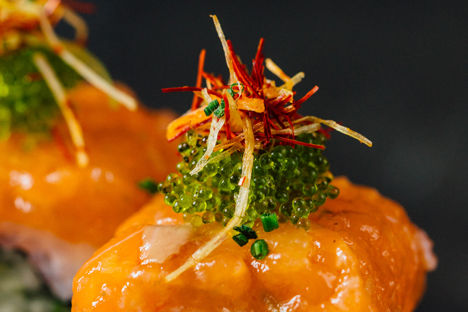
What is tobiko?
You might have seen this colourful ingredient popping up on Japanese restaurant menus – but what is it? And why is it such a popular ingredient in sushi?
What is tobiko?
You might have seen this colourful ingredient popping up on Japanese restaurant menus – but what is it? And why is it such a popular ingredient in sushi?
Crunchy, salty and with a hint of smoke – tobiko has quickly found its way into the UK’s top sushi restaurants over the past few years. They’re the small, orange, pearl-like blobs that sit on top of sashimi, maki and other raw fish dishes from the country, offering some much needed crunch to the softer textures of rice and raw fish.
‘Tobiko tastes like seaweed and I love using it because of its crunchy texture,’ says Hideki Hiwatashi, the head chef at Sake no Hana. ‘It works well in Japanese dishes as the flavours complement things like seafood stock, fermented ingredients and raw fish. Ponzu, yuzu and natto [fermented soybeans] all work well with tobiko.’
As you may have guessed, tobiko is a type of fish roe (or caviar). It comes from flying fish, and while it looks similar to salmon roe (known as ikura in Japan), the eggs are much smaller and differ in texture. They’re often used to garnish dishes, and more extravagant sushi platters are piled high with the roe as a sign of wealth.
However, you may have seen something that looks like tobiko that’s jet black, bright green or pale yellow in colour. This is just the roe infused with other ingredients, allowing the eggs to take on the colour and flavour of something else. They can be so bright and vibrant that you’d be forgiven for thinking that they're artificially coloured, but the eggs' translucency simply means they take on the colours of other ingredients particularly well.
‘Tobiko is often flavoured with things like wasabi, yuzu and soy sauce, which brings something new to sushi and seaweed salads,’ says Hideki, reminiscing about the first time he tasted the unique roe. ‘When I was a child, my mother served it for dinner one night instead of ikura. I still remember how amazed I was by the texture – it was something I’d never tasted before.’
So, why has tobiko only started to appear in restaurants recently? Our increased interest in authentic Japanese cuisine means we’re getting access to all sorts of weird and wonderful ingredients from the country, but even in Japan tobiko is still a relatively new thing. ‘It has always been traditionally eaten in the Shimane Prefecture, but because it was so difficult to harvest it was relatively rare,’ explains Hideki. ‘However, around forty years ago Japanese chefs discovered that Indonesian fishermen – who specialise in catching flying fish – were throwing the roe away. A deal was struck to import the eggs into Japan, and now it is a much more common ingredient.’
So there you have it – next time you see tobiko listed on the menu, give it a try – the crunchy eggs and variety of flavours brings something new to Japanese cuisine, and knowing the story behind it seriously ups your sushi master credentials.


